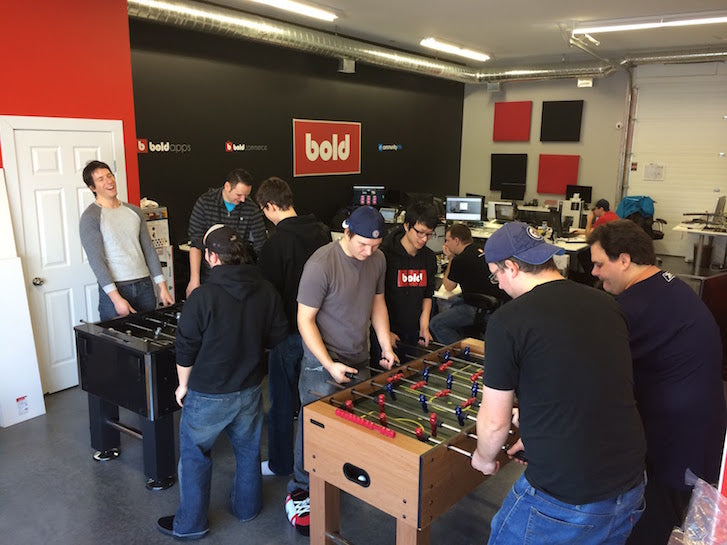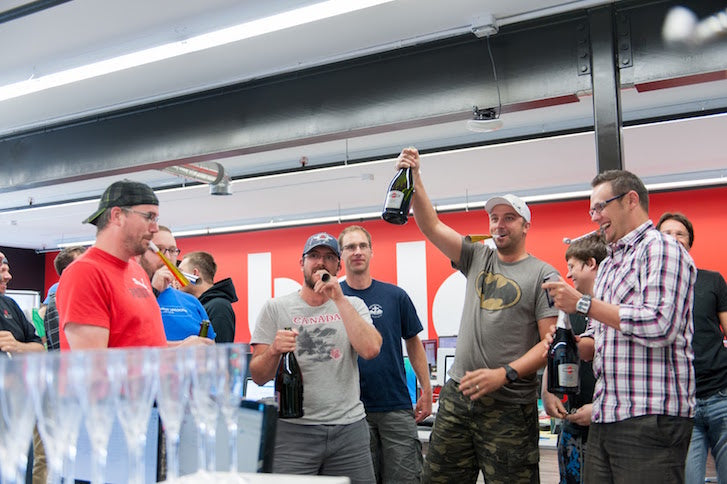In Part I of this series, Bold Apps co-founder Jay Myers shared the story of how him and three friends launched a freelance business building apps for Shopify, and how they navigated the early success of their efforts.
Next, Jay shares insights on scaling the business as app sales continued to increase, as well as deciding to diversify their service offerings to clients. Where should you look for new hires? What skillsets are the most important to recruit for? And how do you get over the uncomfortable hump of going from a handful of friends to a legitimate business? Jay walks us through these questions and more in the second part of this blog series.
Bonus: Read to the end for five pieces of advice that Jay wishes he could pass along to his younger self (and you). In a rush? Skip ahead to Jay's tips.
The interviewing process
In the early days, when Bold was still working out of Jay’s house, they conducted employee interviews down the street at a Starbucks.
“We’d say to them, ‘Are you okay working in a basement? We’ll have an office one day.’ That made it tough. It’s a little weird to ask people to work in your basement.”
While it may have been awkward, there was a very important upside of asking if people were okay working in a basement. It filtered out the candidates that weren’t a good fit for the company anyhow — the ones only interested in the job as a means to an end. Jay found that this allowed them to find the “builders” — the ones who wanted to grow alongside them.
“It was a blessing in disguise. Instead of asking about benefits and vacation days, these were the people who would ask, ‘When can I start building? Where is the hammer? Where are the nails?’”
You might also like: How to Hire Employees: The Essential List of Resources for Agency Owners.
Recruiting strategies
Winnipeg, Manitoba (where Bold is based) isn’t known for its technology sector, so finding local talent was tough. Instead of working with a headhunting firm, which would charge 20% of the employee’s first year salary, the Bold team decided to try a different tactic.
They decided to make their office an incredible place to work. That included investing in things like free lunches, beer kegs, arcade games, and Hack Days where employees can work on side projects they don’t usually get time for. It was a pull method, rather than a push.

The team put ads up around the city. They started speaking at local meetups as well as their three local colleges. They showed up at career fairs. These days, if a student is taking Computer Science in Winnipeg and asks their professor where to apply post-grad, the answer is always the same: “Bold.”
Referrals from existing employees have been a massive boon to hiring as well. Although they don’t offer a hiring bonus, the motivation to get your friend to come work with you is often enough, Jay said. Plus referrals offer a prescreening — Jay trusts that it’s worthwhile to pursue someone a team member has personally vouched for.
Focusing money and attention on the company is one of the things Jay believes the company did right.
“You can’t only focus on building the product,” he said. “You have to build your company too. You’re selling to customers, but you’re also selling to your employees, and a lot of people forget that.”
Traits to hire
These days, Bold receives about 30 resumes per day — the bounty of their word-of-mouth and company-building efforts. But digging out the best fit for the team from a mountain of resumes is a challenge in and of itself. To navigate this, Jay and his team have implemented a controversial strategy: Hire for character, and train for skill.
“You can’t change a person’s personality,” Jay says. “We would hire a mediocre dev who has the best attitude — I’d take them ten times over an amazing dev with a bad attitude that will clash with others.”
While this means that individual skill sets might need building, Jay believes it makes them stronger as a team, and better as a whole.
Growing pains
In the early days, up until about 20-25 employees, Friday afternoons at 4 PM would see the entire office having a beer and playing games together. It was different every week — Monopoly, or beer pong, or foosball. They kept score, and there were prizes. It was a family event not to be missed.

But when they crossed into 30+ employee territory, things began to change. Jay noticed people drifting away on Friday afternoons. There were just too many of them.
There came a point when the company decided that, although they were still one big team, they could spend time in smaller groups to be more inclusive overall. Now, walk around their two offices and you’ll spot sub-teams playing Cards Against Humanity or just chatting over beers.
For Jay personally, his biggest growing pain has been the realization that he needs to stop working in the business and start working on the business. Even though (given his marketing background) he’d prefer to be creating an email campaign, managing social media, or launching Facebook ads, he’s learned to take a step back and focus on the road map: Where does the company want to be in six months? A year? Three?
“It’s hard, but it’s important,” Jay says.
Diversifying client services
Another area where the company has grown is the number of services they offer to clients. Originally, Bold was all in on apps, with the goal of creating one new app each month. They’d get requests all the time to build shops or customize apps for an individual merchant’s needs, and the answer was easy: no.
But the requests kept coming. For every 100 people who installed an app, they’d receive one request to customize it. One of their team members, named James, made a suggestion that changed the company’s trajectory: “Why don’t we just say yes?”
The first month, they sold $15,000 worth of app customizations. The next month it was $30,000, then $80,000, and it just kept growing. Now, Bold has an entire department of 16 developers and designers, doing nothing but custom development work.
This custom revenue stream adds to app sales from their 20 apps in the Shopify App Store, and 20+ private apps that have been built specifically for larger clients.
The company now has a team of 16 people that focus on leads they receive from the Shopify Experts Marketplace, and they’ve also started a webmaster service for those Goldielocks-sized businesses: too small to have someone on staff to focus on running their ecommerce store, but big enough to be able to hire someone externally to do it for them.

Up next? Bold Social — a service including social media, video production, and marketing.
Despite these recent service additions, Jay says the company remains focused on their few verticals, without wanting to be all things to all people. This has been a strategy that Bold’s clients have responded well to.
“We don’t lose customers by saying, ‘We don’t provide that service, but here’s a recommendation for someone who does,’” Jay said. “Clients will respect that much more than you saying yes to everything.”
To wrap up this post, Jay shares some advice he wishes he was able to give to his younger self about entrepreneurship, building a business, and taking more time to focus on small wins.
You might also like: 8 Things I Learned at Beyond The Code
Jay's advice to his younger self (and you)
- Be 10 times more focused than you think you need to be. “There are a lot of projects I’ve taken on that made a bit of money, but I wish I hadn’t spent four months on. Find a way to have no problem saying ‘no’ to projects and people.”
- Figure out your value. “We didn’t know our value in the beginning. When you’re just getting started, you have to think about this — what are you worth? What’s an hour of your time worth? Almost everyone will undersell themselves at first, so don’t be afraid to charge more until you start getting pushback.”
- Plan for growth better. “For a long time, we were spinning our wheels trying to catch up. It was like, ‘Okay, we’re three months behind, we need to hire four devs.’ But now we say, ‘Where are we going to be in three months? Let’s hire for that.’”
- Remember the 80/20 rule. “80% of your revenue will come from 20% of your users. Don’t forget about that 20% — you don’t need to make everyone happy. In fact, if you are making everyone happy, you're probably doing something wrong.”
- Celebrate the small victories. “In the early days, we were so good at this: high-fiving each other every time someone installed an app. But then it was just expected, so we’d celebrate when we hit a major milestone. Small victories are so important for morale, though. Otherwise, you can go a long time without a victory. By celebrating the little things, you create a culture of winning. We come up with a goal every week, and we win at it. Then we celebrate, even if it’s just a small win.”

Next up, in part three, Jay will join us in the present and take a look into the future. What tools do the team use? How has their location impacted the success of their business? And what crazy inventions are they dreaming up in their innovative new division called Bold Labs? Stay tuned...
You might also like: How to Build Your First Shopify App

